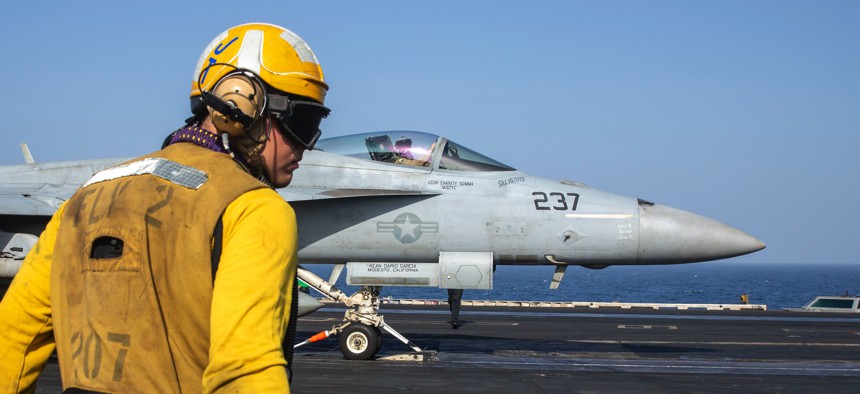
USS Dwight D. Eisenhower (CVN 69) conducts flight operations in the Red Sea on Feb. 10, 2024. Navy / Petty Officer 3rd Class Rylin Paul
The US is not serious about aircraft carriers—or their industrial base
Congress should reject the Navy’s plan to increase the gaps between new carriers.
Last October, Hamas terrorists—acting with the sanction of their Iranian puppeteers—murdered over a thousand innocent Israelis (and Americans), taking hundreds captive. This attack was made against the backdrop of Iranian-backed attacks on U.S. forces elsewhere in the theater, attacks that had become routine. In response, the defense secretary ordered the carrier Gerald R. Ford to take station in the eastern Mediterranean as part of measures to deter further regional aggression.
He was able to do this, and the carrier was able to be there about a day later, because the ship was already in the Mediterranean. It was already there because for decades, defense planners have recognized that deterrence, assurance, crisis response, and naval diplomacy can best be accomplished by robust naval force, forward deployed. So important was the carrier presence there that Ford was extended on deployment and joined shortly thereafter by a second carrier strike group: Eisenhower and its escorts. Ford has since returned the United States, but Eisenhower remains in the Middle East, and its air wing—along with a number of destroyers—are carrying on the Battle of the Red Sea against Iranian-backed Houthi rebels who are disrupting freedom of the seas on a daily basis.
Given the recent importance of aircraft carriers in the Defense Department’s response to real-world tasking—and the fact that such responses have been routine for administrations since World War II—one might assume that aircraft carrier construction and sustainment of the industrial base that supports it would be jealously guarded in the Fiscal Year 2025 Defense Budget. One would be wrong to do so.
Monday’s FY25 budget rollout revealed that the Navy plans to delay procurement of the next aircraft carrier—CVN 82—by at least two years, from 2028 to beyond the new five-year plan that ends in FY 2029. Had the last three years not occurred—Russian aggression in Europe, Iranian aggression in the Middle East, Chinese blustering in the Indo-Pacific—the Biden Administration’s lukewarm interest in naval forward presence and the continuing utility of aircraft carriers could be explicable. But the last three years did happen, and the value of mobile, lethal, carrier-based air power in addressing these developments has been obvious.
The impact of delaying CVN 82 for at least two years would be considerable. The Navy currently plans to allow six years to elapse between the starts of construction of CVN 81 and CVN 82, which—according to the Aircraft Carrier Industrial Base Coalition, or ACIBC—would cause nearly half of advance-procurement suppliers to cease continuous production. An additional two years of delay would exacerbate that problem, and ACIBC says 40 percent of its members predict they would have to lay off workers and/or deprioritize military shipbuilding. These developments would represent steep challenges to the continued production of aircraft carriers. And because many suppliers of aircraft carrier parts also furnish components for submarines (both are nuclear-powered), the delay would also undermine the already insufficient submarine industrial base.
There is already evidence in the Ford program of the impact on program performance and industrial base flexibility of excessive gaps between acquiring ships. There was a 6.5-year gap between the procurement of CVN 79 and CVN 80, and supply chain effects from both the length of the gap and the global pandemic are contributing to delays in completing CVN 80. If CVN 82 acquisition is delayed until 2030, this will represent a 7.5-year gap between it and CVN 81, at a time when the nuclear industrial base will already be hard-pressed with submarine requirements. (CVN 81, which was purchased as part of a two-ship “block buy” with CVN 80, is not reported to be suffering construction delays.)
Worst of all, such long gaps will ultimately shrink the Navy’s carrier fleet, whose nuclear cores have a definite and predictable lifespan. Today’s 11-carrier fleet can barely keep two forward simultaneously and indefinitely—a post-Cold War requirement that is today at least one-third too few.
The submission of a defense budget is just one step in the process, and Congress should act to return CVN 82 to this five-year plan—not to FY 28 as was in the FY24 budget proposal, but to FY 26—and provide immediate funding for required advance procurement. There is no foreseeable future in which tactical aviation will not play a role in U.S. war plans, and there is no more survivable and mobile means to employ it than a U.S. aircraft carrier. Congress knows this, and it should act.
Bryan McGrath is the Managing Director of The FerryBridge Group defense consultancy. The ideas expressed here are his.

